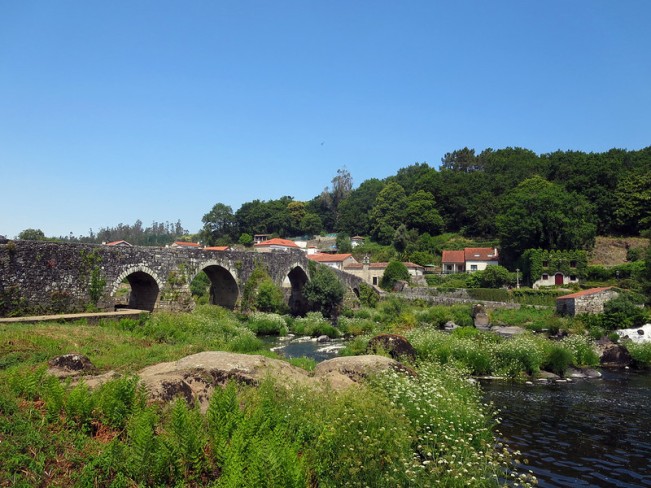Last week, on New Years Eve, the Twitter world had a #CaminoTuesday theme of “The Old and The New.” I didn’t have time to write up a whole blog post, but I did share this:
Here are the photos bigger, in case you’re curious:


And that got me thinking about bridges, and how important they are to the Camino experience.
“We build too many walls and not enough bridges,” said Isaac Newton. Saint Dominic de la Calzada would have agreed. The 11th century hermit-turned-priest, born in Burgos, found his calling in engineering easier paths for the growing swells of pilgrims to Santiago de Compostela, starting with a bridge over the River Oja.
Today, he is the Patron Saint of Spanish Civil Engineers. He probably deserves a blog post all to himself. Because the bridges of the Camino de Santiago expand past just his work.
Here are a few of my favorites from my Camino walks in 2015, 2017, and 2018, and, when possible, links to the stories they inspired:
The Pont-Vieux, Espalion, France:
(Tucked under this 14th century bridge, just across from the 16th century castle, is a very surprising 20th century scuba diver. Click here to read the story.)

The Pont Valentré, Cahors, France:
(This defensive bridge on the Via Podiensis comes complete with a legend about the devil himself. Click here to read it.)

Pont d’Artigue, Larresingle, France:
Just outside Larresingle, the medieval fortified village on a short Via Podiensis variant past Condom

Saint Jean Pied-de-Port:
In the bright light of mid-day sunshine, the colors of this bustling town still shine.

Pamplona, Spain:
Approaching the walled old city, this gentle bridge was just the first of our surprises. Click here for the full story of my day in Pamplona.

Puente La Reina, Puente La Reina, Spain:
The bridge of the queen, possibly one of the most iconic, historic places of the Camino Frances.

Puente del Paso Honroso, Hospital de Orbigo, Spain:
The site of jousting knights fighting for true love and honor (one of my favorite Camino history stories), this is also one of the longest bridges of the Way of Saint James.

Ponte Nova, Portomarín, Spain:
This “new bridge” carries the growing swells of pilgrims on the final days of the Camino Frances.

Ribadiso, Spain:
This 12th century bridge, which as far as I can find doesn’t have a name, was witness to one of my favorite nights on the Camino Frances, and a story I tell often.

Ponte Maceira, Negreira
On the way to Finisterre, the sun was hot and all of the bars were closed for the Feast of Saint John the Baptist, we paused at the Río Tabmre for a dip in the shade of this lovely bridge.

Vizcaya Bridge, Portugalete, Spain:
Lest you think that everything on the Camino is medieval and stone, I’ll finish with this, just past Bilbao on the Camino del Norte. I wrote about our trip across the Nervion River on this UNESCO-recognized hanging bridge, on the Camino del Norte, here.

I know this just barely touches the surface of the beautiful paths over water. What am I missing? What was a place you loved?
(It also brings up several stories that I’ve never told here. How have I never talked about wild swimming on the Camino? That must be remedied. Guess I’ll renew the domain and keep the blog alive for another year.)



Beautiful indeed. Such an amazing place I just wish I can be there some day.
LikeLike